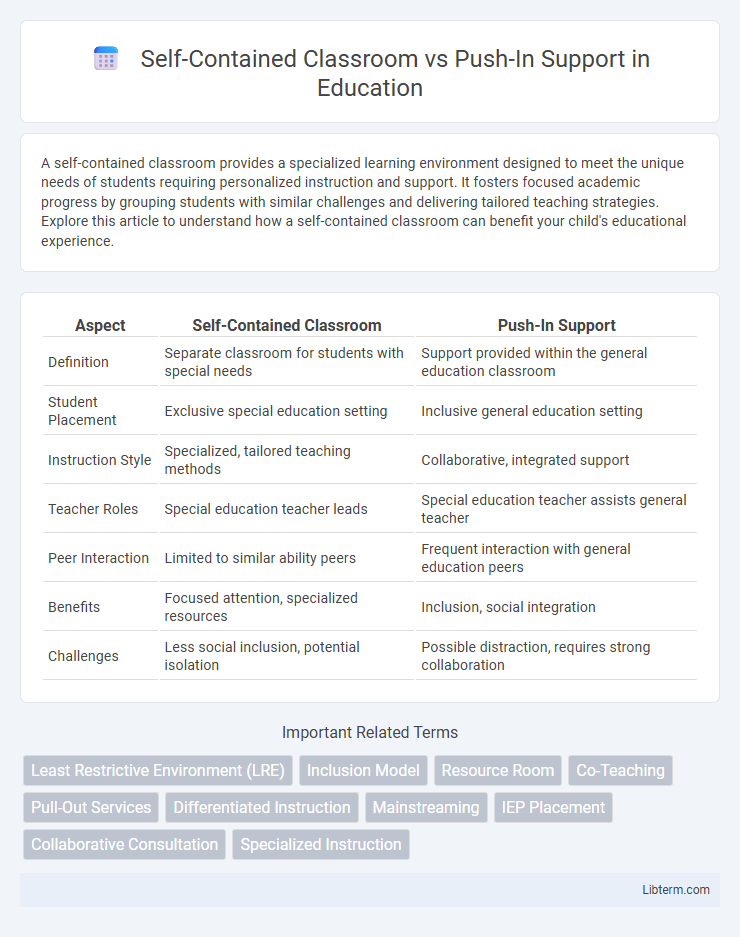A self-contained classroom provides a specialized learning environment designed to meet the unique needs of students requiring personalized instruction and support. It fosters focused academic progress by grouping students with similar challenges and delivering tailored teaching strategies. Explore this article to understand how a self-contained classroom can benefit your child's educational experience.
Table of Comparison
| Aspect | Self-Contained Classroom | Push-In Support |
|---|---|---|
| Definition | Separate classroom for students with special needs | Support provided within the general education classroom |
| Student Placement | Exclusive special education setting | Inclusive general education setting |
| Instruction Style | Specialized, tailored teaching methods | Collaborative, integrated support |
| Teacher Roles | Special education teacher leads | Special education teacher assists general teacher |
| Peer Interaction | Limited to similar ability peers | Frequent interaction with general education peers |
| Benefits | Focused attention, specialized resources | Inclusion, social integration |
| Challenges | Less social inclusion, potential isolation | Possible distraction, requires strong collaboration |
Introduction to Self-Contained Classrooms and Push-In Support
Self-contained classrooms provide a structured learning environment where students with similar educational needs receive specialized instruction from a dedicated teacher, fostering focused academic and social development. Push-in support involves special education professionals collaborating within general education classrooms to offer targeted assistance while promoting inclusive learning. Both models aim to accommodate diverse learners by balancing individualized support with opportunities for social integration.
Defining Self-Contained Classrooms: Key Features
Self-contained classrooms are specialized educational settings where students with similar disabilities receive instruction from specially trained teachers tailored to their unique learning needs. These classrooms offer a structured environment with modified curricula, focused on individualized instruction and social skills development. Key features include smaller class sizes, specialized resources, and consistent routines designed to enhance student engagement and progress.
Understanding Push-In Support: Core Characteristics
Push-in support involves a special education teacher or aide providing assistance within the general education classroom, promoting inclusive learning environments and peer interaction. This approach emphasizes individualized support without removing students from the mainstream setting, fostering academic and social development simultaneously. Core characteristics include collaboration between general and special educators, real-time intervention, and tailored accommodations to meet diverse learning needs on-site.
Benefits of Self-Contained Classroom Settings
Self-contained classroom settings offer tailored instruction that meets the unique educational and behavioral needs of students with disabilities, fostering a structured and supportive learning environment. These classrooms provide specialized resources, individualized attention from trained educators, and consistent routines that enhance skill development and academic progress. Concentrated support within a self-contained classroom promotes social-emotional growth and reduces distractions, helping students achieve better focus and confidence.
Advantages of Push-In Support Models
Push-in support models enhance inclusive education by allowing special education teachers to provide individualized assistance within the general education classroom, promoting peer interaction and reducing social stigma. This approach fosters collaboration between general and special educators, leading to tailored instructional strategies that support diverse learning needs more effectively. Data shows students in push-in settings often demonstrate improved academic performance and social skills compared to self-contained classroom environments.
Challenges Associated with Self-Contained Classrooms
Self-contained classrooms often present challenges such as limited social interaction opportunities for students with disabilities, which can affect their social development and peer relationships. These settings may also restrict access to the general education curriculum, leading to potential gaps in academic achievement and reduced exposure to grade-level content. Furthermore, staffing constraints and the need for specialized training can impact the quality of individualized instruction and support provided within self-contained environments.
Limitations of Push-In Support in Inclusive Education
Push-in support in inclusive education often faces limitations such as restricted individualized attention and difficulty managing diverse student needs simultaneously within a general education setting. Teachers may struggle to deliver tailored instruction during push-in sessions, leading to inconsistent support for students with disabilities. This approach can also disrupt the flow of general classroom activities, potentially hindering overall learning outcomes.
Factors to Consider When Choosing an Educational Model
When choosing between Self-Contained Classroom and Push-In Support models, factors to consider include the student's individual learning needs, level of social interaction required, and the availability of specialized staff. Self-Contained Classrooms offer tailored instruction in a separate setting, ideal for students needing intensive support, while Push-In Support integrates special education services within general education classrooms, promoting inclusion and peer interaction. Evaluating the student's cognitive, behavioral, and communication needs alongside school resources ensures the best fit for educational success.
Impact on Student Outcomes and Social Development
Self-contained classrooms offer specialized, individualized instruction tailored to students with significant needs, often resulting in improved academic outcomes for those requiring intensive support. Push-in support integrates specialized educators within general education settings, promoting inclusive social interactions and enhancing peer relationships, which contribute positively to social development. Combining targeted academic interventions with inclusive social experiences maximizes both educational achievement and social skills for students with diverse learning needs.
Best Practices for Implementing Effective Support Systems
Effective support systems in special education balance self-contained classrooms and push-in support by tailoring instructional methods to individual student needs. Best practices emphasize collaborative planning between general and special educators, continuous progress monitoring, and flexible grouping to enhance inclusion and academic growth. Data-driven decisions and professional development ensure both environments adapt to evolving student goals and foster meaningful participation.
Self-Contained Classroom Infographic

 libterm.com
libterm.com